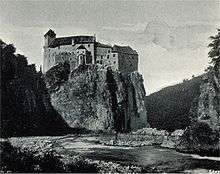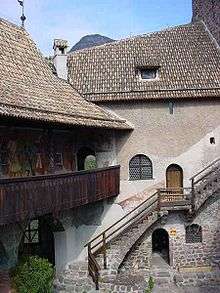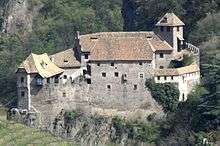Runkelstein Castle
Runkelstein Castle (German: Schloss Runkelstein; Italian: Castel Roncolo) is a medieval fortification on a rocky spur in the territory of Ritten, near the city of Bolzano in South Tyrol, Italy. In 1237 Alderich Prince-Bishop of Trent gave the brothers Friedrich and Beral Lords of Wangen permission to construct a castle on the rock then called Runchenstayn.


History
In 1274 it was damaged during a siege by Meinhard II of Tirol, who after winning the war against Heinrich Prince-Bishop of Trent, entrusted the castle to Gottschalk Knoger of Bozen. In 1385 the Niklaus and Franz Vintler wealthy merchant brothers from Bozen bought the castle. Niklaus was counselor and financier of the Count of Tyrol, Leopold III, Duke of Austria, which allowed them to buy the castle a type of residence unfitting in this time for people of their rank. The brothers Vintler commissioned a vast restructuring of the castle: a new defence wall, moat, a cistern and more rooms were built. In 1390 the construction of the Summer House began. The house was painted with frescos, for which the castle is most famous today, inside and outside. The frescos topics were of literary nature, depicting i.e. King Arthur and his knights, Tristan and Isolde, Dietrich von Bern. The family also commissioned the frescoes in the Western and Eastern Palace. They were created by an unknown masters and some of them depict scenes from Pleiers romance Garel.[1]

In 1407 the monetary conflict between Frederick IV, Duke of Austria “mit der leeren Tasche“ (with empty pocket), Count of Tyrol and wealthy Tyrolean noble families resulted in open war. The Vintlers were drawn into these disputes and Runkelstein was besieged. Niklaus, who had allied with himself with the nobles in the "Hawk League" lost all his wealth and possessions. His brother Franz, who had allied with the Duke remained owner of the Castle until Sigismund, Archduke of Austria “der Münzreiche” (rich with coins) acquired it.
The Habsburg family owned the castle until 1530. Holy Roman Emperor Maximilian I gave order to renovate the castle. He furnished his apartment and commissioned a restoration of the frescos. He also ordered his Coat of Arms to be prominently displayed in the castle. Around 1500 Maximilian gave the castle to his vassal Georg von Frundsberg, famous “Father of the Landsknechte”. Frundsberg entrusted the care of the castle to a vicar. In 1520 the powder magazine on the groundfloor of the tower exploded. The explosion damaged parts of the outer wall, entrance and Eastern Palace and destroyed the tower. Afterwards the castle was neglected until King Ferdinand I bestowed it in 1530 to Sigmund von Brandis, Knight Commander of Bozen.[2]
Later the Prince-Bishop of Trent obtained the castle anew and Prince-Bishop Bernhard von Cles gave it as a feud to the Counts of Lichtenstein-Kastelkorn. In 1672 a fire destroyed the eastern palace, which was never rebuilt. In 1759 the last Liechtenstein-Kastelkorn gave back the fief to the Trentine bishops. At the time the castle was in grave decay.
During the Romanticism period in the early nineteenth century romanticists rediscovered Runkelstein. Johann Joseph von Görres, a German writer was the first to come and was soon followed by the many artists in the service of King Ludwig I of Bavaria. In this time the castle became a symbol for the Romantic period. In 1868, the northern wall of the Summer House collapsed, but in 1880 the castle's fortunes changed: Johann Salvator Archduke of Austria bought Runkelstein and gave it as a gift to Emperor Franz Josef in 1882. The emperor commissioned Friedrich von Schmidt to restore the Castle and after the restoration donated it to the city of Bozen in 1893. The last restoration, including a careful restoration of the frescos was carried out in the late 1990s.[3]
References
- Tax, Petrus W. (1991). "Der Pleier". In Lacy, Norris J., The New Arthurian Encyclopedia, pp. 362–363. New York: Garland. ISBN 0-8240-4377-4.
- http://www.runkelstein.info/runkelstein_en/history.asp
- http://www.runkelstein.info/runkelstein_de/geschichte.asp